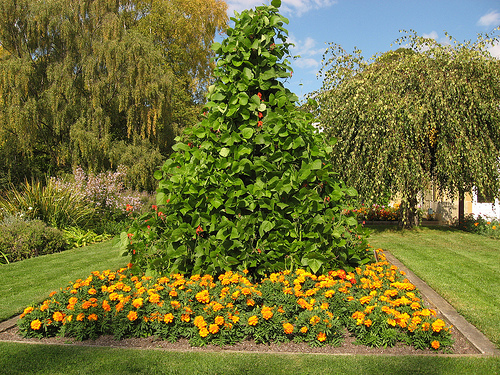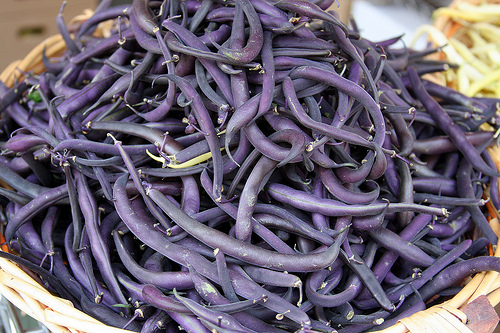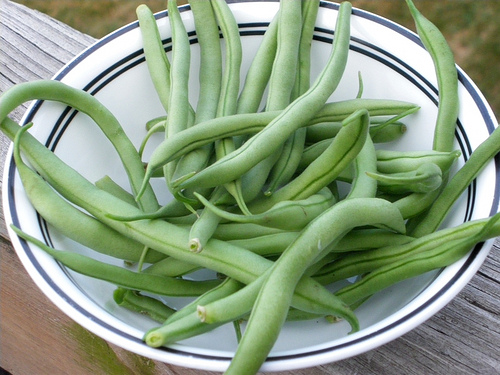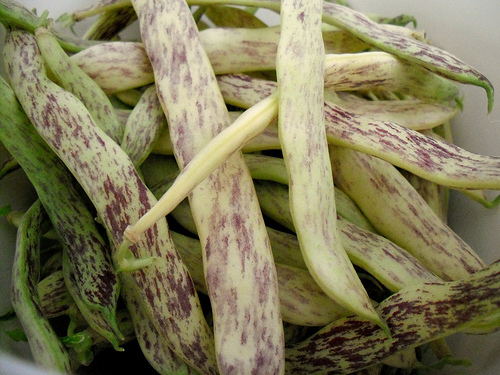Among the easiest vegetables to grow are beans, making them ideal for beginning gardeners. Plus, beans come in a wide range of fun colors, from purple and yellow to speckled. Read on to find some helpful tips for growing beans, plus a few of our favorite varieties to consider for your garden.

Bean teepee photo via Jonahtheg/Flickr Creative Commons
Beans are part of the Fabaceae plant family, which was formerly known as the Leguminosae. This vegetable can be grown and eaten as tender young pods, and some are grown for their dried seeds as they mature, such as pinto or kidney beans. They’re all pretty much grown the same way.
How to start and grow beans
- Select a sunny part of the garden that gets at least 6 hours of sunlight daily.
- Start your beans by sowing seeds 1″ deep into well-draining soil. Wait until after the last frost date before you plant. Ideally, the soil should be above 60 degrees for the best germination rates.
- If you’ve never grown beans in that spot before, try inoculating your seeds first. This will increase the yields of your beans significantly. Inoculants can be found at garden centers in the spring. Just roll the bean seeds around in the inoculants before you plant.
- Keep the soil moist as the seeds germinate. You may need to watch for birds nibbling on little seedlings. I often cover my seedlings with bird netting. Once the plants start to grow, birds aren’t usually a problem any longer.
- Beans don’t need particularly rich soil, because they can draw nitrogen from the air and convert it into plant food. Inoculated beans are better able to handle the nitrogen fixation process.
When to harvest beans
Beans can ripen at different times, based on their variety and whether you are growing dry beans. So, always look at the seed package to see when plant maturity is expected. Typically, about 2 months after planting, the beans will begin to form on the plant.
Harvest beans when they are slightly fatter than a pencil, and about 4 to 7 inches long, depending on the variety. Pick the pods often, so it encourages more bean production. Don’t handle bean plants that are wet, however, to avoid spreading fungal diseases.
If you are growing dry beans, allow the pods to remain on the bean plant until they are fully dried. Wait until the leaves have turned brown or have fallen off. This can take up to 70 to 120 days after sowing.
Bush beans vs. pole beans
Pole beans grow on vines that can reach 10 to 12 feet long, so make sure you have a trellis or teepee nearby to support their growth. Allow 60 to 85 days for beans to start producing from seed, depending on the variety.

Bush beans photo via Tclarkcreations/Flickr Creative Commons
Bush beans grow a couple feet tall and don’t need to be supported with a trellis. Their beans tend to come a bit earlier than pole beans, and they all mature around the same time. Allow 50 to 60 days for the beans to start producing.
Different types of beans to grow
Here are a few noteworthy beans to try in your garden:
Pole beans
- Ideal Market Green Beans: The productive plants grow lots of medium-sized green beans that are crispy and stringless. (65-70 days)
- French Gold Pole: Slim yellow beans reach 7 to 9 inches long and grow on heavy-bearing vines. (60 days)

Purple podded pole beans via Muy Yum/Flickr Creative Commons
- Purple Podded Pole: Pretty heirloom grows 6 feet tall with bright purple beans that turn green when cooked. (68 days)
- Rattlesnake Pole: These striking beans are green streaked with purple. This variety is particularly popular in hot, humid climates. (65 days)
Bush beans

Blue lake bush bean via paix120/Flickr Creative commons
- Blue Lake Bush: This “standard” for dark-green beans was developed in 1961. (60 days)
- Borlotto Bush: Popular in Italy, the white pods with red streaks make good snap beans when young. Later, the dry beans are light pink with darker red mottling, and are great as a baked bean. (65-70 days)

Dragon tongue bean via Jenniferworthen/Flickr Creative Commons
- Dragon Tongue: This pretty Dutch heirloom is yellow with purple streaks, and is beloved by chefs. (55 days)
- Golden Wax: Stringless golden-yellow beans are featured on this old-fashioned favorite bush bean. (55 days)
You might enjoy showcasing your freshly harvested beans in this recipe for braised green beans with smashed tomato vinaigrette.

Share tips, start a discussion or ask one of our experts or other students a question.
Already a member? Sign in
No Responses to “Beginner's Guide to Growing Beans”